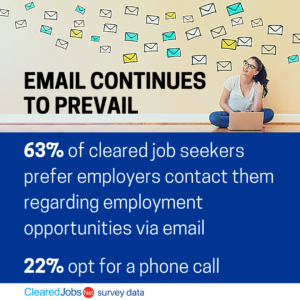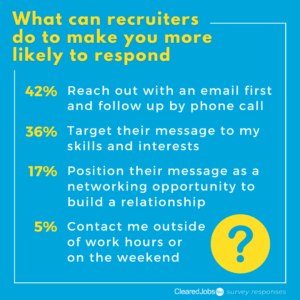INSIDE THE 
NEWS + ADVICE
How to Make Potential Candidates Respond to Your Outreach Efforts

We surveyed cleared job seekers and 38% said that recruiters contacting them is their most helpful job search tool—ranking above searching for jobs online, attending job fairs, or even getting referrals from their network. But you know filling positions isn’t as simple as reaching out to candidates that fit the bill. In fact, when we asked our community of employers about the most challenging thing about recruiting during the pandemic, 31% said getting candidates’ attention is difficult.
We’ve all sent messages to cold candidates at some point in time and failed to hear back from them. They may be the perfect fit for the position, but if they won’t respond, you can’t move them through the recruitment funnel any further. Your goal is to capture their attention and get them to communicate back to you.

So instead of sending generic mass communications and waiting to see what sticks, tailor your communication strategy with the following tips to improve your response rates and lead to more conversions that deliver top tier hires.
Why You’re Being Ignored
Before you invest energy in improving your outreach strategy, let’s first identify some of the most common reasons why people don’t respond to recruiters. It’s often because the position doesn’t match the persons’ interests, but let’s look at some other specifics.
We asked cleared job seekers what bothers them the most about recruiters’ outreach. Here’s the top three responses—watch out for these issues in your own communication efforts:
- I’m not a good target for the job the recruiter is suggesting
- I do respond, but I don’t hear back
- The recruiter isn’t interested in my needs, just filling their openings

Other common problems include:
- You caught the candidate at a bad time
- They’re not open to making a change in employment
- The location of the job isn’t a fit
- Your message was too generic
What Are the Odds of Engagement
Before committing to ongoing follow-up efforts, identify whether the person in question is a promising lead—this goes beyond sourcing for qualifying skills. Looking at career patterns can help you determine the odds of funneling the candidate through the recruitment process successfully.
This means doing some research to conclude if they are likely to be open to new opportunities. Look at their job history (i.e. on LinkedIn or on a job board profile). Do you see a pattern in how long they typically stay in a role before moving on? Did they recently begin a new position? Does their career path match your position?
Answering questions like these will give you an idea of whether your outreach attempts will likely be successful or not. Otherwise, it’s a coin flip—if that. Generally speaking, the odds are about 50/50 as to whether or not someone is open to considering a new position at all. According to a 2021 Job Seeker Nation Report, “While 67% of respondents are satisfied with their jobs, 50% are still open to other job opportunities.”

In the cleared community specifically, 52% of our survey respondents said they’re always looking for their next opportunity. Additionally, another nine percent of respondents said they start looking for a job when a recruiter contacts them about a new opportunity. So while the odds are pretty good that a cleared professional may be in the market, you still need to engage them and match your opportunity to their specific interests and abilities.
Timing Your Outreach
The phrase timing is everything is key to getting a response. You’ve already looked at your prospect’s career pattern, so hopefully the timing for a career move in general is right. As a cleared recruiter, you’re used to reaching out ‘after hours’ to accommodate professionals working in SCIFs. So continue to avoid the 9 to 5 hours and focus on early morning and evening.
You’re aiming to enter those inboxes or get someone to pick up the phone when their schedule is more open. 7pm on a Wednesday might yield good results, but Monday morning won’t likely be as successful when people are getting in the mindset to tackle a new week of responsibilities. Typically, around 6am and between 7-10pm are the ideal times for sending a message that will be received and responded to.
Bonus Tip: Most people wake up and almost immediately look at their phones, so this a great time to capture their attention before distractions set in.
When reaching out to transitioning military personnel, you’ll find that mornings won’t be as successful as in the civilian sector. Mornings can be a tough time to reach active duty personnel if they have organized PT with their unit. So if you’re hoping to make contact when they can actually answer, reach out after the workday.

Communication Methods
When thinking about where we initially communicate with candidates, two methods immediately come to mind: phone and email. When we asked cleared job seekers how they prefer to be contacted regarding employment opportunities, a whopping 63% wanted an email. The next favored communication method was a phone call.
If you’re considering one contact method over another, think about which generation you’re targeting. Typically Millennials prefer email, Gen Xers have equal preference for email or phone calls, and Boomers prefer phone calls.
Where is your prospective candidate most likely to respond? When contacting military personnel, a phone call will likely serve you better, as an email may not get through due to heightened security and firewall.
And don’t be deterred if a candidate doesn’t respond to your initial outreach efforts – it pays to be persistent. In fact, we asked cleared job seekers what one thing recruiters could do to make them more likely to respond. 42% of respondents said they want recruiters to reach out with an email first and then follow up by phone call. This was the top response.
Every communication sent is another opportunity to engage and prompt a reply. So follow up, but consider using a different channel (including social media platforms). This can be subtle—a soft touch that brings you back to the top of their mind and shows you’re still invested. Instead of sending five emails, make contact in different ways. This could be an email, followed by a phone call or text message, a LinkedIn connection request and an InMail message, or a retweet.
How to Engage Candidates
If you tailor your communications effectively and engage your target candidate from the start, the number of follow-up attempts needed before getting a response will likely be reduced. Use these ideas to engage your prospects efficiently:
PERSONALIZATION
How do you create an engaging message that cuts through the noise? Personalization. This is one of the most crucial factors in eliciting a reply. A generic message sent to countless people isn’t going to motivate a response from a passive candidate or someone who is in high demand. If it looks like you copied and pasted the same message to a dozen people, they’re not as likely to bother responding.

Use the research you conducted at the beginning of this process to identify what makes them unique, accomplishments you can compliment, or any commonalities you may share that you can use as an icebreaker. 36% of surveyed cleared job seekers said targeting your message to their skills and interests is the one thing recruiters can do to make them more likely to respond.
So directly reference the skills and experiences that make them a great fit—this shows you’ve done your homework and the email was written specifically for them. And by complimenting an achievement, you help form a positive, feel-good opinion.
Overall, make it about them, not you. The big picture is that you want to focus on how the job opportunity relates to the candidate, not overload them with information about yourself or your company up front.
ASK A QUESTION
Ask a question to turn your message into a conversation. But don’t set yourself up for dismissal by asking if they have time to hear about your position. A passive candidate will mostly likely respond “no” or send no response at all.
A more engaging question is, “What are some of the challenges you are looking to tackle in your career?” Asking a question like this can help position your outreach as a networking opportunity. That can be specifically useful when communicating with transitioning military folks who may not be ready to accept a job for a few more months.
KEEP IT SHORT
While you want to personalize your message, you don’t want to write a novel detailing everything on a candidate’s public profile. Similarly, you shouldn’t paste the entire job description into your message. People are busy, attention spans short, and candidates want a succinct message between 150-250 words. Give enough detail to pique their interest and entice them to want to know more.
If you employ these strategies on a consistent basis, you should see your response rates improve. And with greater response rates comes greater opportunity to secure the best possible hire.
This entry was posted on Tuesday, April 13, 2021 12:03 pm
